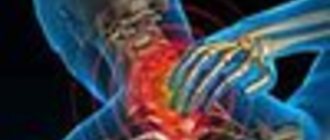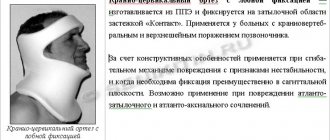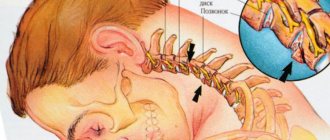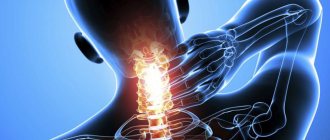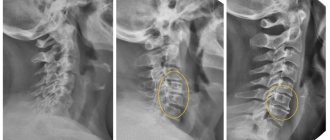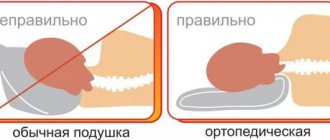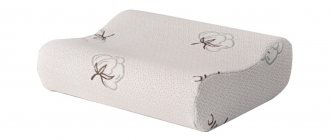With cervical osteochondrosis, destructive and degenerative changes develop in the tissues of the spine. Very often this disease occurs atypically, that is, without any characteristic symptoms. Many people turn to different specialists and only over time find the true cause.
With complicated cervical osteochondrosis, compression of the vertebral arteries occurs, which leads to disruption of blood microcirculation in the brain. This condition can cause ischemic stroke. Alexander Yurievich Shishonin, a candidate of sciences, head physician of the Clinic of Doctor Shishonin, organizer of the Club of Former Hypertensive Patients, a specialist in the field of orthopedics and cardiology, talks about how a stroke develops with cervical osteochondrosis.
What features of the cervical spine cause symptoms of osteochondrosis?
- There are openings in the lateral processes of the vertebrae; the carotid arteries, which supply blood to the brain, pass through them to the right and left.
- The initial part of the spinal cord passes through the cervical region - it contains fibers that carry nerve impulses to all parts of the body, provide movement and sensitivity. If the spinal cord is compressed in the neck, neurological disorders occur throughout the body.
- This section of the spinal column has great mobility, and this predisposes to the occurrence of osteochondrosis (although, in most cases, the disease still develops in the lumbar region - it not only has high mobility, but also experiences the greatest stress).
- In the neck area, nerve roots emerge from the intervertebral foramina, forming the cervical and brachial nerve plexuses. They are responsible for movements in the muscles of the neck, arms, shoulder girdle, skin sensitivity, and regulation of autonomic functions.
- The first vertebra does not have a massive front part - a body - it is a bone ring that fits onto the tooth - a bone outgrowth on the second vertebra. Thanks to this, it is possible to turn the head to the sides.
Neck pain, headaches, feeling of weakness, numbness in the hands are symptoms that should make you consult a neurologist. An examination by a specialist and examination using modern equipment will help you understand the causes of the pathology and take the most effective measures.
Take care of yourself, book a consultation now
Message sent!
expect a call, we will contact you shortly
Tools used
The choice of medications for the treatment of cervical osteochondrosis will depend on the causes of the pathology and the changes that have occurred. Drugs that improve cerebral circulation are represented by the following list:
- Actovegin;
- Berlition;
- Xanthinol nikonate;
- Trental;
- Eufillin.
Actovegin
If memory function is affected, appropriate measures are necessary. Memory impairment often occurs with hypoxia and problems with blood circulation, so the drug Actovegin is suitable. It successfully copes with these phenomena and increases vascular tone. The use of Actovegin allows you to normalize the metabolic process in the patient’s body and improve trophism.
Berlition
Berlition has an active ingredient - thioctic acid. It has a vasodilating effect and leads to restoration of the functioning of neurovascular formations. In addition, with its help, energy processes occurring in nerve tissues are restored, and cerebral circulation improves. Another positive quality of Berlition is associated with its effect on the liver, so the use of the drug leads to improved functioning of this organ.
Xanthinol nikonate
Xanthinol niconate contains two active ingredients - nicotinic acid and theophylline. The presence of such components makes it possible to have an antiplatelet effect, as a result of which microcirculation improves, the blood is saturated with oxygen, and metabolic processes are normalized. Cerebral circulation also improves, which is associated with the expansion of the lumen of peripheral vessels.
Trental
Trental belongs to the group of vasodilating drugs that improve blood viscosity. It is necessary to restore microcirculation and saturate the blood with oxygen by increasing delivery. Often used for problems with cerebral circulation and treatment of pathological conditions. Trental is very effective, therefore it is used in the presence of consequences resulting from a failure of cerebral circulation:
- When concentration deteriorates.
- During memory degradation.
- When headaches, dizziness and other manifestations occur.
Eufillin
Eufillin is a bronchodilator drug. Used when necessary to get rid of bronchospasm. It has a striking antispasmodic effect. In addition, its advantage is the improvement of cerebral and peripheral blood supply. Eufillin prevents the occurrence of blood clots. There are several forms of the drug for the treatment of cervical osteochondrosis, which will allow you to use the most appropriate type:
- injections;
- tablet forms.
Starting treatment with Eufillin and the previously presented drugs is required after visiting a doctor and receiving a prescription.
If Eufillin was taken incorrectly, side effects may occur:
- Cramps.
- Painful sensations in the heart area.
- Decreased blood pressure.
What happens to the vertebrae with cervical osteochondrosis?
The obscure medical term “degenerative process” refers to the following pathological changes occurring in the cervical spine:
- First of all, damage to osteochondrosis affects the intervertebral discs. They become thinner, thus reducing the distance between adjacent vertebrae. Small tears and microcracks form in their outer parts. Over time, this can lead to a herniated disc.
- As a result of disc damage, the stability of the vertebral connection is disrupted.
- Intervertebral joints also suffer from osteochondrosis of the cervical region - spondyloarthrosis develops. It also contributes to compression of the nerve roots.
- The pathological process extends to the vertebrae themselves. Due to the fact that the functions of the intervertebral discs are disrupted, the load on them increases. The spine tries to compensate for this violation, and bone growths appear on it - osteophytes.
Choosing effective medications
To treat cervical osteochondrosis and normalize blood circulation, different groups of drugs are used:
- Muscle relaxants.
- NSAIDs are non-steroidal anti-inflammatory drugs.
- Chondroprotectors.
- Analgesics.
- Vasodilator medications.
- Vitamin complexes.
Drugs that improve cerebral circulation are of great importance. The functioning of the brain depends on this function, since it requires nutrients. Problems with blood supply inevitably lead to various conditions, the most dangerous of which is stroke.
Vasodilators are often prescribed during the development of cervical osteochondrosis and cerebrovascular accidents. These medications include drugs whose action is aimed at reducing the tone of smooth muscles. This leads to an increase in the lumen of blood vessels, so cerebral circulation improves. Thus, the effect of vasodilators is represented by the following features:
- smooth muscles have a relaxing effect;
- change in the sensitivity of nerve endings.
The use of this group of drugs leads to the following results:
- Elimination of stagnant processes occurring in the blood.
- Improving blood circulation in diseased joints and tissues.
- Restoring the functionality of nerve impulses.
Treatment of osteochondrosis of the cervical spine
During an exacerbation of osteochondrosis of the cervical vertebra, traction is used (the patient is placed on a bed with a raised headboard and the head is fixed using a special loop) to relieve the intervertebral discs. For the same purpose, you need to wear a Shants collar. Painkillers and anti-inflammatory drugs are prescribed to relieve pain. For severe pain that does not go away, the doctor can perform a blockade: inject an anesthetic solution into the area of the affected nerve roots. Physiotherapy is used: ultrasound treatment, electrophoresis with novocaine.
When the exacerbation subsides, treatment of osteochondrosis of the cervical spine involves massage, physical therapy, and physiotherapy.
Doctors at the Medical Center International Clinic Medica24 know how to effectively treat osteochondrosis of the cervical spine and will give recommendations that will help prevent another exacerbation. Our administrators will answer you at any time of the day, contact us by phone +7 (495) 230-00-01.
Take care of yourself, book a consultation now
Message sent!
expect a call, we will contact you shortly
One of the main signs of cervical osteochondrosis is neck pain. Many people who encounter this symptom do not go to the doctor, but prefer to treat “chondrosis” with home methods. There are at least two good reasons to refuse self-medication and consult a specialist doctor.
Firstly, painkillers and traditional methods, although they help temporarily relieve pain, do not solve the main problem. Pathological changes in the spinal column continue to increase. Over time, this can lead to more serious consequences. To the point where surgery may be required.
Secondly, neck pain occurs not only with osteochondrosis. There are plenty of other reasons. Only a doctor can understand and prescribe the correct treatment.
What symptoms of osteochondrosis of the cervical spine should make you see a doctor?
The main symptom of cervical osteochondrosis is pain. It can occur in different places, depending on the level at which the pathological process is localized: in the neck, in the shoulder girdle, in the arm, in the heart area. The pain is dull in nature and can be burning or aching.
Other manifestations of the disease:
- Headaches, dizziness, spots before the eyes, noise, ringing in the ears.
- Weakness in the muscles of the neck, shoulder girdle, and arms.
- Impaired skin sensitivity.
- Humeroscapular periarthritis: aching pain in the neck that spreads to the arm, difficulty abducting the arm above 90°, weakness and atrophy of the shoulder girdle muscles.
- Shoulder-hand syndrome: pain in the shoulder and hand, swelling and stiffness of the fingers, weakness and atrophy of the muscles of the hand.
- Vertebral artery syndrome. Bone growths appear on the vertebrae, which compress the nerves, resulting in a reflex spasm of the vertebral artery, which takes part in the blood supply to the brain. Symptoms of cervical osteochondrosis include constant headaches that start from the back of the head, spread to the temple, to the crown of the head, nausea, noise in the head, ringing in the ears, flickering bright spots before the eyes.
- Anterior scalene syndrome. On the neck there are the anterior and middle scalene muscles - they are nearby, and between them there is a small space in which nerves and blood vessels pass. With osteochondrosis of the cervical spine, the anterior scalene muscle becomes tense and compresses them, resulting in symptoms such as pain on the inner surface of the forearm, shoulder, and fingers. Sometimes the pain radiates to the back of the head. The skin of the hand may become cold, pale, and numbness occurs.
- Epicondylitis syndrome. In the lower part of the shoulder, on the sides of the elbow joint, there are bony protrusions - epicondyles. With epicondylitis syndrome caused by cervical osteochondrosis, pain occurs in them, which intensifies when pressed. Other symptoms also occur: pain in the neck, pain when pressing certain points in the area of the cervical vertebrae.
If two parts of the spine are affected at once, with cervicothoracic osteochondrosis, symptoms may include pain between the shoulder blades, in the area of the heart.
With osteochondrosis, the risk of intervertebral hernia and stroke increases. If you experience the symptoms listed above, consult your doctor.
Our expert in this field:
Vasinkina Inna Yurievna
Neurologist
Call the doctor Reviews about the doctor
Causes
The fundamental cause of CNC is similar to the etiology of coronary heart disease. It is based on a violation of fat metabolism: cholesterol plaques accumulate on the walls of blood vessels, inhibiting the usual blood flow. The pathological mechanism gradually leads to complete occlusion of the arteries, ruptures of the vascular wall, and the formation of aneurysms.
The following groups of reasons are distinguished:
- compression (due to prolonged compression due to scoliosis or osteochondrosis, cervical circulation is disrupted);
- post-traumatic (bruise, concussion, fractures);
- vasospastic (hypertension);
- occlusive (neoplasms);
- collateral (liver cirrhosis).
Factors that provoke the onset of the disease include:
- chronic fatigue syndrome;
- excess weight;
- impaired metabolism (diabetes mellitus);
- burdened heredity;
- bad habits (alcohol, smoking);
- taking oral contraceptives.
Chronic cerebrovascular accident is most often caused by hypertension and metabolic disorders. If we are talking about mesenteric thrombosis (blockage of abdominal vessels), then the cause must be sought in diffuse cardiosclerosis and acquired heart defects. When circulatory disorders occur in the lower extremities, the provoking factors are Raynaud's disease, obliterating endarteritis (smoker's disease), and varicose veins.
Treatment of symptoms of cervical osteochondrosis
It is better not to self-medicate. Even if you have proven methods that usually help cope with pain, this does not mean that you are doing everything right.
Pain can be caused not only by osteochondrosis, but also by intervertebral hernia, muscle disorders (myofascial pain syndrome), and be a symptom of other diseases. In order to properly treat the disease, you need to understand its causes and carry out differential diagnosis. This is only possible in a clinical setting.
In order to identify the cause of the disease and properly treat the symptoms of cervical osteochondrosis, you need to visit a neurologist and undergo an examination.
Visit a specialist doctor at the Medical Center International Clinic Medica24. Make an appointment by phone at any time of the day: +7 (495) 230-00-01.
We will call you back
Message sent!
expect a call, we will contact you shortly
Cervical osteochondrosis is based on damage to the intervertebral discs. Their chemical composition is disrupted, first they swell, then decrease in size, cracks and tears appear in their outer part, and they become denser. Then the degenerative process spreads to the vertebrae and intervertebral joints. By reducing the height of the intervertebral disc, the load on the vertebrae increases, and bone growths – osteophytes – appear on them.
Diagnostics
Allopaths carry out diagnostics according to medical protocols:
- clinical blood test;
- biochemical blood test (coagulogram, lipidogram);
- ECG, ultrasound of the heart;
- Ultrasound duplex examination of blood vessels;
- selective contrast venography;
- scintigraphy;
- tomography.
The Tibetan Medicine Clinic “Naran” adheres to the traditional Eastern method for determining the true cause of the disease:
- Detailed inspection and survey. The doctor asks about the patient’s habits, diet and lifestyle. Examines the sclera, tongue, condition of nails and skin.
- The performed pulsometry helps to establish the type of constitution of the patient and understand the problem in detail.
- Making a diagnosis based on the frequency, intermittency of breathing, as well as the timbre and sound of the voice.
What causes lead to the occurrence of osteochondrosis of the cervical spine?
There is no consensus on the causes of cervical osteochondrosis. It is believed that the disease is caused by different conditions, there are different points of view:
- Age-related changes in the spine. However, almost all people over 40 have skeletal changes, but not everyone develops osteochondrosis.
- Neck injuries. Often the causes of the disease include previous trauma: neck bruise, compression fracture, vertebral subluxation. Chronic injuries may be important, for example, during intense training in athletes, constant work in an awkward position, bent over, and repetitive whiplash injuries in motorists.
- Congenital anomalies of the vertebrae: cervical ribs, fusion of adjacent vertebrae, fusion of the first vertebra with the occipital bone, etc.
- Profession. More often, the disease affects people who work in a monotonous position and constantly make the same type of movements.
- Poor blood supply to the spine, venous insufficiency, swelling in the area of the nerve roots.
- Autoimmune disorders . Conditions in which the immune system does not function properly and attacks the body’s own connective tissue and ligaments.
Visit a neurologist. An experienced specialist will understand the source of your health problems and prescribe the correct treatment.
Causes of exacerbation of cervical osteochondrosis
Osteochondrosis occurs in the form of alternating exacerbations and periods of improvement, when the symptoms cease to bother you for a while. Another exacerbation can be triggered by the following reasons:
- Awkward, sudden movement of the neck.
- Staying in a monotonous uncomfortable position for a long time. For example, your neck may begin to hurt after working on a computer for a long time, or after sleeping on an uncomfortable pillow.
- Stress, nervous tension. With chronic stress, spasms occur in the neck muscles, which can cause another exacerbation.
- Various diseases, exacerbations of chronic diseases.
- Hypothermia. For this reason, many people experience exacerbations in the fall.
- Incorrect, illiterate self-medication. For example, massage and therapeutic exercises are useful during remission, but are contraindicated during an exacerbation.
What diseases can have similar manifestations?
Very often, manifestations of “osteochondrosis” are actually associated with a completely different disease. For example, the cause may be hidden in the muscles - there is a condition called myofascial pain syndrome . Pain occurs due to constant tension in the same muscles.
Sometimes dizziness associated with otolithiasis, a condition in which crystals of calcium salts accumulate in the inner ear, is taken to be a manifestation of “cervical osteochondrosis.”
Each situation needs to be analyzed individually. A neurologist at the International Clinic Medica24 center will correctly assess your symptoms, prescribe the necessary examination, establish a reliable diagnosis and recommend effective treatment. Appointments can be made 24 hours a day by calling +7 (495) 230-00-01.
Get a consultation with a doctor
Message sent!
expect a call, we will contact you shortly
Pain and crunch in the neck, headaches - when these symptoms occur, many people “diagnose” themselves with osteochondrosis. Everything is clear - when it hurts, you need to take painkillers or get an injection, apply heat, and everything will go away. Why go to the doctor if you can handle it yourself?
However, self-medication often does not lead to anything good. Painful attacks may become more frequent, severe, and prolonged over time. If you uncontrollably take painkillers almost every day, you can get stomach or kidney problems. After all, any medicine has side effects.
And the cause of pain is not always due to osteochondrosis. In order to find out the real reason and understand how to effectively deal with it, you need to visit a doctor and undergo an examination.
Varieties and stages
The stages of chronic cerebrovascular accidents depend on the severity of complaints and symptoms:
- At the first stage, a blurred clinical picture is observed. The patient complains of general malaise, constant fatigue, intense headaches and random attacks of dizziness begin to manifest themselves. Emotional instability is characteristic - irritability turns into tearfulness.
- Circulatory disorders at the second stage are manifested by deterioration of memory and intellectual abilities. A person is unable to concentrate on anything and is bothered by constant noise in the ears and head. The emotional background decreases - depressive disorder begins. The patient adapts poorly to new conditions.
- The third stage is characterized by an intensification of all the above symptoms. The patient suffers from memory loss, speech impairment, uncoordinated movements, and develops dementia.
The last stage is the complete death of brain cells, dementia. It becomes dangerous to let a person leave the house alone, since his memory is completely atrophied.
Types of cerebrovascular accidents:
- Thickening of the walls of blood vessels, narrowing of the lumen of small arteries and veins due to age-related atherosclerosis or Binswanger's disease (atherosclerosis before the age of 40 years).
- Death of white and gray matter due to multiple point areas of necrosis. This option is possible for frequent hypertensive crises.
- Heart rhythm disturbances (most often atrial fibrillation in a jelly-like embolus, which risks blocking the access of oxygen to one of the main arteries.
How does a neurologist diagnose cervical osteochondrosis? What happens in the doctor's office during an examination?
During your first appointment, the neurologist will ask you some questions:
- How long have you been bothered by headaches or neck pain?
- Where does the pain occur? What is their nature: stabbing, aching, shooting, pulling?
- When does pain usually occur? What triggers it? After what do you feel better?
- Have you already visited a doctor? Have you been examined and treated? Which? How long ago?
- What other symptoms bother you?
- What other chronic diseases do you have?
- Have you recently had a neck injury?
The doctor will then perform a neurological examination, checking your reflexes, skin sensitivity, and muscle strength and tone. You will be asked to turn, tilt your head to the sides, forward, backward. The doctor will press lightly on your head and on certain points in the neck to determine the occurrence of pain.
After the examination, you will be diagnosed and prescribed the necessary diagnostic methods.
The medical center International Clinic Medica24 employs experienced neurologists and uses the most modern diagnostic methods. You will be quickly and reliably diagnosed and prescribed effective treatment methods.
Take care of yourself, book a consultation now
Message sent!
expect a call, we will contact you shortly
What diagnostic methods are used for osteochondrosis of the cervical spine?
Examination for cervical osteochondrosis usually includes the following diagnostic methods:
- X-ray of the cervical spine.
- According to indications, X-ray contrast studies are prescribed: myelography (injection of contrast into the space surrounding the spinal cord), discography (injection of contrast into the intervertebral disc), angiography (injection of contrast into the vessels).
- CT scan.
- Magnetic resonance imaging.
- If you have severe neurological disorders, you may be prescribed electroneuromyography, a study that determines the passage of electrical impulses in the nerves and muscles.
Often, manifestations of cervical osteochondrosis resemble angina pectoris. If after the examination the doctor still has doubts about the diagnosis, you will be prescribed an ECG and other diagnostic methods.
The material was prepared by Lev Gennadievich Kamyshev, a neurologist at the international clinic Medica24.
There is a common professional proverb among doctors that a correctly established diagnosis is half the successful treatment of a disease. Get diagnosed for osteochondrosis of the cervical spine at the neurology center of the International Clinic Medica24 in Moscow. Contact the clinic administrator by phone, we work around the clock.
